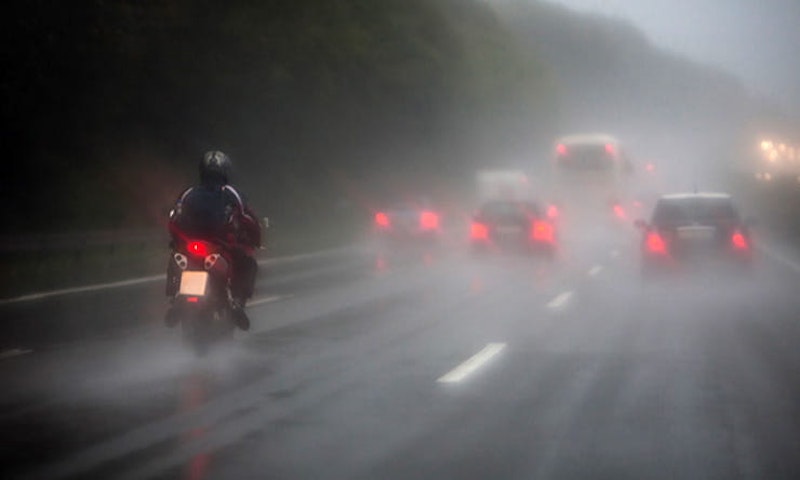Rider skills: better wet weather riding
By Gary Baldwin
Director of Rapid Training
08.01.2018
If you want to ride all year round in Britain or, like many, your bike is your only form of transport, then you’ll inevitably end up riding in the rain. For most of is that means a dramatic decrease in speed and total absence of fun. But it need not be that way…
How much grip is there in the wet?
Quite a lot – usually a lot more than riders expect. As part of my job as a crash investigator I have to measure the co-efficient of friction (COF) on roads and on a good dry road we would expect a COF of around 0.7 – that’s a ratio of how much sideways force is required to move a block compared to its weight, so on a dry road a 1kg block would require about 7N of force to shove it sideways. If the road is wet, the COF would be about 0.5 and if it was icy you’d get about 0.1.
Now, 0.7 to 0.5 is significant - it’s about 30% – but it’s not a huge drop-off. Yet if you were to look at riders’ percentage speed reduction it’s much greater than that. It’s like a switch – riders see a wet road and suddenly ride very slowly, not exploiting any grip at all. Also, when I’m following someone on a training course as the conditions deteriorate I often see tension start to build in their shoulders, and then they get locked elbows. And that tells me things are going to get worse, because you have to be relaxed to ride well. You’re part of the bike and when you’re tense, it doesn’t work properly. I tell people to occasionally flap their elbows about, and if they can’t they’re tense. If they just relaxed and trusted their tyres they might even enjoy it.
Where is the grip? Is it better in some places than others?
Yes. It’s the stones in the road that give the grip, not the tar - that’s just there to hold the stones in place - so you need to avoid parts that have been polished by the traffic. That’s probably biggest difference for me when I’m riding in the wet - I’m actively searching out the best bit of road to ride on, whereas normally I’m looking for the best position for visibility, to see round a corner, past a hazard or whatever.
So I should take different lines in the wet?
Exactly. On a dry day with a road surface like sandpaper I’ll ride on the perfect line for view, using as much of the road as possible to see through the corner, then creating an apex when I can see the exit. But on a wet road, I compromise that line because my speed will have dropped off, so I probably don’t need as much vision, but I do need better grip. And that will probably mean riding somewhere slightly different to avoid low grip areas. You need to be able to stop the bike within your vision, and in the wet, that might be easier to do if you’re riding on a grippier patch of road than if you have slightly more vision.
How about roundabouts? Presumably you don’t slice across as normal?
It’s the same principle as above. Around wet roundabouts you’re looking for the line that keeps you the most upright because there’s probably loads of oil and diesel and you don’t want to be leant over, so that might mean you take your usual line, only slower. But missing manhole covers and white lines is important too - you need to see these in the early stages of your scan, make a plan to avoid them and then not look at them again. It’s so easy to think ‘Jesus, look how shiny that is,’ stare at it, and ride straight over it.
How do you feel for grip in the wet?
With difficulty. You are trying to feel feedback, which is what makes the difference between a nice set of tyres and an ordinary set. You usually get a feeling of slight uneasiness, sometimes a mild floating sensation, as you approach the limit. It’s the sort of thing you should only learn on track because at least if you go over the limit you probably won’t hurt yourself. Even then it’s something to experiment with gently.
And finally, what about tyres?
If you’ve got modern sport-touring tyres, there is absolutely no reason why you can’t have a brisk, smooth, enjoyable ride in the wet. Icy roads are of course a different matter. Full-on trackday tyres can be treacherous in the wet because they are designed to operate at a temperature that you’ll struggle to achieve in the wet. Consequently, they’ll usually offer far less wet grip than a decent sport-touring tyre. And of course cheap (or old) tyres with a low silica content are also unlikely to work well in the wet.

